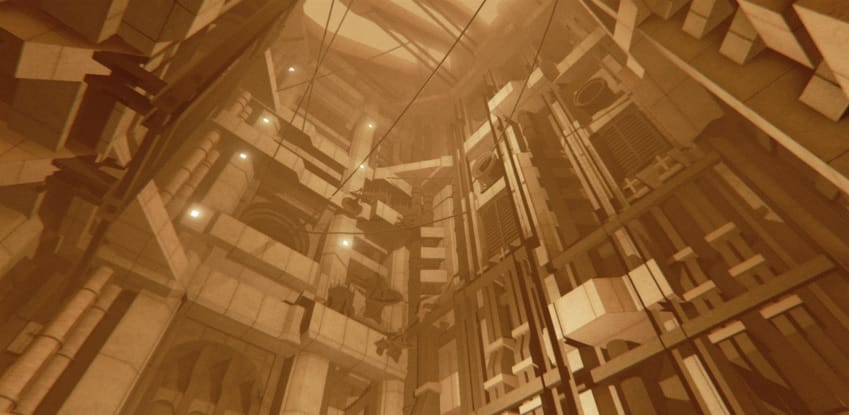The influence of Blame! on videogame architecture is rising

Blame! (1998) is getting everywhere these days. The dark, vast architectural spaces of Tsutomu Nihei’s manga series seem to be steadily rising in popularity, like sentient tower blocks growing stories at a time, casting a deeper and deeper shadow over popular culture. Next year it’ll likely hit the mainstream as an anime film adaptation is coming to Netflix. But perhaps Blame!‘s best utilization isn’t in film but in videogames. There are number of game makers who seem to think so.
claustrophobic urban details
One of those is Aloft Studios, who revealed last week that they’re working on a game called Megastructure on the TIGSource forums. It’s said to be an environmental exploration game that mostly relies on the player’s interpretation of its spaces to make sense of the story. But this isn’t a case of reading graffiti written on the walls or investigating a corpse in someone’s overturned office (you know, the usual); the structures to be explored are kept vague, and are said to be “of vast but unknown dimensions and scope, consisting of many layers of accretional industrial systems layed upon one another in an organic fashion over a vast number of years.”
It’s the same technique that Nihei used in Blame!, committing almost totally to the language of space: Blame! is largely wordless, and so the reader must spend their time piecing together the story through an interpretation of the claustrophobic urban details of “The City,” the symbols hidden within the structures, and the spaces between the panels.






Within this, Nihei presents a huge biopolis—a living city—that stretches out for millions of miles and is endlessly being built upon. It is an urban organism that questions our humanist assumptions of architecture, as “The City” doesn’t seem to exist in servitude of humanity, but supports what David Gissen calls “subnature.” Gissen uses this term to refer to entities like smoke, gas, dust, debris, puddles, mud, insects, and weeds—those that traditionally threaten the constitution of architecture—but in terms of Blame! it can be used to refer to the immensity of the city’s architecture and spaces, its many depopulated zones, and the post-humans that dwell within.
left to navigate the circuitous trenches
This same idea of architecture against humanity is described by Aloft Studios when talking about Megastructure. “The environments themselves tend toward the monochromatic (principally through lighting), and have a quality of paradoxical detail and ‘sameness’ simultaneously, which is a kind of mild sensory deprivation,” reads the description. “There is also a tendency for the player to experience long stretches of time in transit through spaces of great scale, rather than engaged in action-oriented tasks.”

The studio acknowledges that this unconventional approach to game design can also be seen in NaissanceE (2014). It is a game that has the player explore a “primitive mysterious structure,” huge in scale, and seemingly devoid of human life. It is a place sustained and populated by machines, by light and shadow, and that seems unfriendly towards the player merely by way of the vast layout of the place, which includes infinite staircases and a negligence for proper passageways.
Aloft Studios also acknowledges other similar projects, such as Hiversaires (2013), a point-and-click game by Aliceffekt, the prototype game called ABANDON that never amounted to anything, and another game currently in the works described by its creator as “walking simulator about climbing gray stairs surrounded by gray walls surrounded by gray structures in gray rooms stretching for gray kilometers.” What all these works have in common is that their creators have been inspired by Blame! and looked to transpose its design approach to a videogame. The appeal is obvious: rather than trying to nake 3D sense of Nihei’s spaces as a reader, make the spaces actually 3D and put the player at the center, marooned, left to navigate the circuitous trenches and sprawling urban ecology by themselves.
You can look for updates on Megastructure over on the TIGSource forums.




